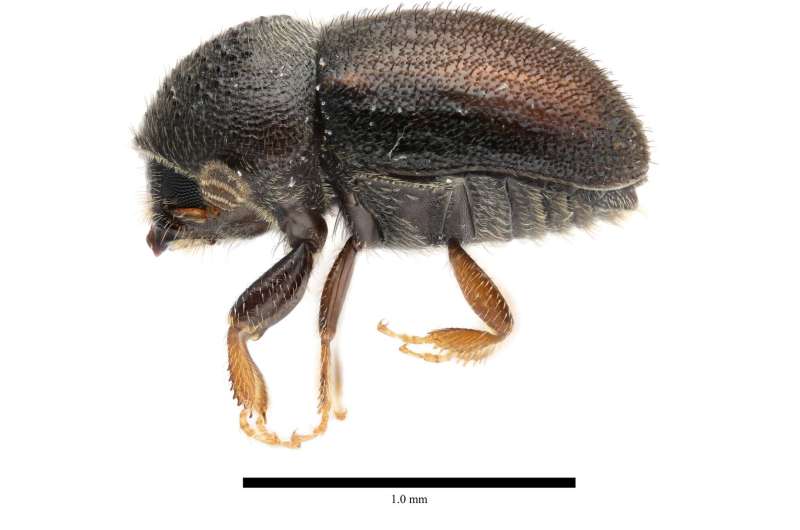New species of loquat-killing beetle identified

If you live in an area where winter temperatures routinely drop below freezing, you may have never even heard of the evergreen loquat tree and its delicious fruit. But it may be troubling to hear that a new bark beetle pest of loquats has been identified in China by the University of Florida's Forest Entomology Lab. A new paper describing the beetle has just been published in the journal Insects.
The beetle, newly named Cryphalus eriobotryae, was first observed in April of 2018 in a tree nursery near the city of Suzhou in Jiangsu, a coastal province of China. Loquat trees were dying for unknown reasons. There are no other insect pests known either to specialize in loquat trees or to kill them. But when the problem spread to other areas during the summer of 2018, it became clear that a real problem had emerged.
Chunrong Chu, a technician with Suzhou's forest service, and Sizhu Zheng, an entomologist with Suzhou's customs agency, sent photos and specimens of the beetles to the UF Forest Entomology Lab for identification, led by Dr. Jiri Hulcr. The lab has staked out an unusual specialty in the entomology world. Having already built the world's largest cryo-collection of bark and ambrosia beetles, Hulcr's team established a volunteer service for the global identification of bark and ambrosia beetles.
Dr. Andrew Johnson, a research scientist in the UF Forest Entomology Lab, was studying the genus. He quickly realized that he was looking at an entirely new species. He named the beetle eriobotryae in reference to the name of the genus of plants to which loquats belong. "By giving this a name and recognizing it as a potential threat, we can encourage further work," said Johnson. "Before giving it a name, it is difficult to coordinate and to work on this species."
The work has barely started. The beetles' DNA has recently been sequenced and analyzed via a method that examines one very specific part of a genome in order to determine its identity. But a full pre-invasion assessment has not been conducted. It is still not clear exactly where the beetle came from, what its potential is as an invasive species, or what means can be used to prevent and fight future outbreaks.
Bark beetles are a group of insects including thousands of species that chew holes through the bark of a tree and feed on the phloem just beneath the bark. They live most of their lives invisibly, breeding and rearing their young in tunnels called galleries. Most bark beetles only colonize recently dead trees, but some species may turn their attention to living trees and can kill them, sometimes on a massive scale, as with the Southern pine beetle.
In affected areas of Jiangsu, the threat of the loquat beetle is not an obscure issue. Loquats are as economically and culinarily important as, say, oranges in Florida or avocados in Mexico. "Local people really want to know how to control and kill this pest," says Dr. You Li, a scientist with the UF Forest Entomology Lab who also contributed to the paper. "That's why they are happy we could tell them more about this beetle."
So far, the loquat beetles have all been found in nurseries, which may be a clue to the origins of the beetle and the means of its spread. Transportation of live plants from one location to another is a frequent vector for movement of invasive species that can hitch a ride.
The process of loquat death begins when beetles make tiny holes at the base of the tree. This progresses up along the trunk as the offspring of the initial beetles mature and start tunnels of their own. As the galleries of beetles become more dense, eventually, the tree may be girdled around its circumference. At that point, it is no longer able to move water and nutrients from the roots to the leaves. The leaves rapidly turn brown and die while remaining attached to the branches.
More information: Sizhu Zheng et al. Cryphalus eriobotryae sp. nov. (Coleoptera: Curculionidae: Scolytinae), a New Insect Pest of Loquat Eriobotrya japonica in China, Insects (2019). DOI: 10.3390/insects10060180
Provided by Emerging Threats to Forests Research Group















